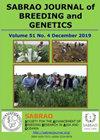ROLE OF BIOTECHNOLOGY IN FOOD SECURITY: A REVIEW
IF 1.7
Q3 PLANT SCIENCES
引用次数: 0
Abstract
One of the most serious issues confronting the global food system is the wastage of approximately one-third of food at various points throughout the supply chain due to environmental and economic factors. Declines in production and food quality deterioration are concerns due to less awareness of the farming community and end users about the advanced technologies. Therefore, scientists face to develop cutting-edge technology to solve these problems and feed the bulging population to prevent starvation. Genetic engineering (GE) techniques can aid in several contexts to boost crop yields and quality. Biotechnology, genetic modification, and recombinant (r) deoxyribonucleic acid (DNA) technologies are significantly beneficial in pursuing chief progress in food production and supply. This latest literature review illustrates the recent advances in GE, their sources, current trends, and future. GE foods from animals, microbes, and crop plants have altered DNA and introduced modified genetic characteristics. Genetically modified organisms (GMOs) are vital parts of the industrial food system, and most packaged foods contain GMO ingredients that received engineering for resistance to pesticides and herbicides. Several issues raise red flags concerning GMOs, including safety, effects on the environment, and ineffective usage of pesticides. Many people are anxious about GMOs; however, most do not understand the problems.生物技术在粮食安全中的作用综述
全球粮食系统面临的最严重问题之一是,由于环境和经济因素,在整个供应链的各个环节上浪费了大约三分之一的食物。由于农业社区和最终用户对先进技术的认识不足,产量下降和食品质量恶化令人担忧。因此,科学家们面临着开发尖端技术来解决这些问题,并养活不断膨胀的人口以防止饥饿。基因工程技术可以在几种情况下帮助提高作物产量和质量。生物技术、基因改造和重组脱氧核糖核酸(DNA)技术对追求粮食生产和供应的主要进步具有重要意义。这篇最新的文献综述说明了通用电气的最新进展,它们的来源,当前趋势和未来。来自动物、微生物和农作物的转基因食品改变了DNA,引入了改良的遗传特征。转基因生物(GMOs)是工业食品系统的重要组成部分,大多数包装食品含有转基因成分,这些成分经过了抗杀虫剂和除草剂的改造。转基因生物的安全性、对环境的影响以及杀虫剂的无效使用等几个问题引起了人们的警觉。许多人对转基因生物感到焦虑;然而,大多数人并不理解这些问题。
本文章由计算机程序翻译,如有差异,请以英文原文为准。
求助全文
约1分钟内获得全文
求助全文
来源期刊

Sabrao Journal of Breeding and Genetics
农林科学-奶制品与动物科学
CiteScore
1.90
自引率
50.00%
发文量
63
期刊介绍:
The SABRAO Journal of Breeding and Genetics is an international journal of plant breeding and genetics research and was first published in 1969. It is the official publication of the Society for the Advancement of Breeding Research in Asia and Oceania (SABRAO).
Its objectives are to: promote the international exchange of research information on plant breeding and genetics, by describing new research findings, or ideas of a basic or practical nature; and be a medium for the exchange of ideas and news regarding members of the Society.
The Journal gives priority to articles that are of direct relevance to plant breeders and with emphasis on the Asian region. Invited for publication are research articles, short communications, methods, reviews, commentaries, and opinion articles. Scientific contributions are refereed and edited to international standards.
The journal publishes articles for SABRAO members mainly. The Journal preferred strongly that at least one author should be a current member of the Society. Non-members may also publish in the journal.
 求助内容:
求助内容: 应助结果提醒方式:
应助结果提醒方式:


